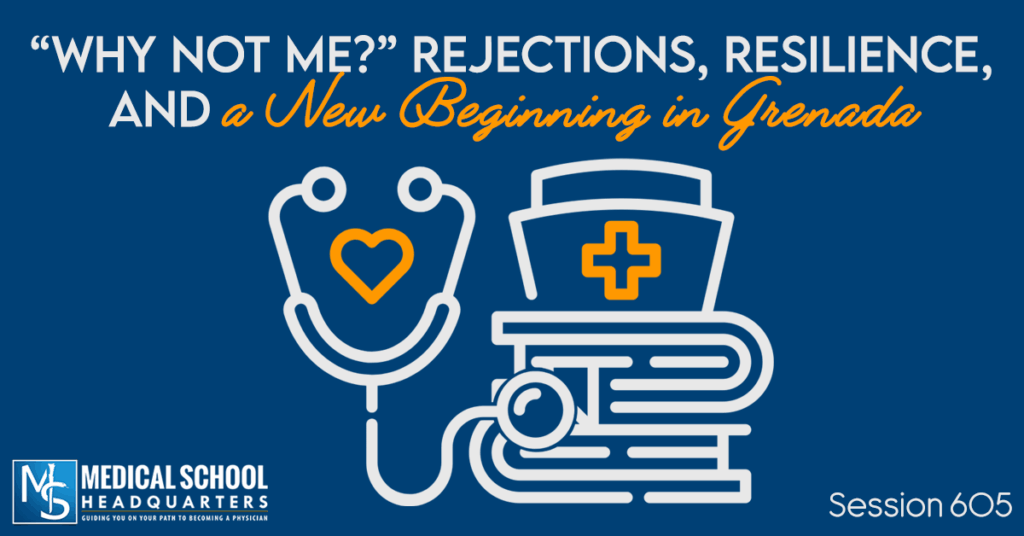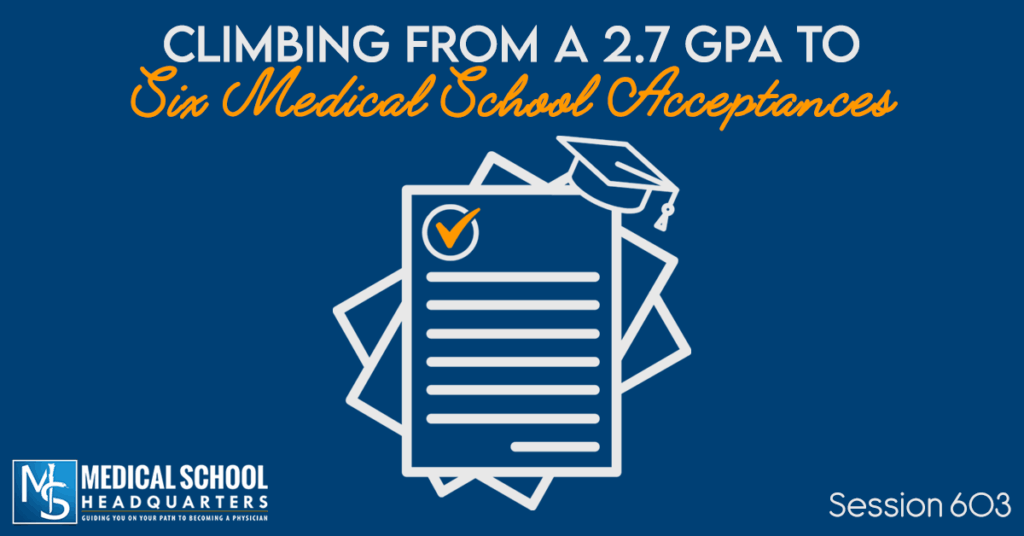The AMCAS is the American Medical College Application Service, a centralized application service used by premed students when applying to medical school. It lets you create one application which is then sent to all of the allopathic medical schools to which you’re applying.
How it works
- Complete your AMCAS application and submit online.
- Once you submit your AMCAS application and release your transcript, your application will begin being processed. (Note: both your application and transcript must be received for application processing to begin. The processing of your application entails confirming your coursework and calculating your AMCAS GPA. AMCAS processing can take up to 6 weeks.)
- Review your Course work (AMCAS grades, semester hours, course classifications, verified AMCAS GPA). If you find anything in your application that you disagree with, you must submit an Academic Change Request within 10 days of the date that your AMCAS application has been processed.
- Your application package (AMCAS application + AMCAS GPA + transcript) will then be sent to all of the schools that you designate on the AMCAS website. Your letters of recommendation will also be sent out as they are received.
- Medical schools will send you secondary applications.
- Promptly complete and submit your secondary applications.
- Promptly respond to invitations for interviews at medical schools.
- Once you make a decision, promptly notify AMCAS and the other medical schools where you have interviewed that you will be matriculating at a specific school.
Read more about the medical school application timeline here.
Things to Keep in Mind
- Meet deadlines early or on time! As they say in the military, early is on time, on time is late, and late is unacceptable! The last thing you want to do is be at a disadvantage because you got your application materials in late. If you do get down to the wire, please note that all AMCAS deadlines are considered to be on that particular date at 11:59pm.
- Read all questions carefully! Applications will be returned to you if there are errors, and this may result in missing deadlines.
Peak applying time is June through September, so be aware that applications received during this period may take longer to process.
How to complete your AMCAS application:

Before getting into the nuts and bolts—gather these required things:
- Transcripts from any post-high school, even if you didn’t earn credit. There is a specific AMCAS Transcript Request Form (available from the Main Menu in AMCAS)—get extra copies to help you complete the application.
- List of all work and extracurricular activities. There is a maximum of 15, so pick wisely which to include. Choose which was the most memorable; you’ll have space to explain yourself.
- List of people who wrote your letters of recommendations
- List of Medical Schools you want to apply to
- Personal Statement (5,300 character max)
- MCAT Scores (typically must be within the last 3 years)
- GMAT/LSAT/GRE depending on what programs you are applying to
- $160 non-refundable application fee (includes 1 school submission)
- $34 for each additional school designation (after the first)
Check out our Medical School Applications Cost Estimator for more on the application expenses.
How to Complete the AMCAS: The Step by Step Guide
Log-in to AMCAS application using your AAMC username and password. Now we’ll go through all the sections of the application.
Section 1: Identifying Information
Enter your name.
Enter your ID numbers from your transcripts.
Enter your birthdate.
Enter your gender.
Section 2: Schools
High School: Enter your High School. (See AMCAS Instruction Manual if you got a GED, were home-schooled, or attended high school in a country outside the USA.)
Colleges: List every institution you attended after high school, even if you only took 1 class there. Enter all schools even if your credits were transferred, no credits were earned, or you withdrew from the class/school.
Transcripts: You need a copy of your official transcript from each U.S., U.S. Territorial, or Canadian institution post-high school where you’ve attempted course work, regardless of whether you earned any credit.
You need to use the AMCAS Transcript Request From with each official transcript. If you don’t, AMCAS will have problems connecting your transcripts to your application. This is the number one cause of processing delays and missed deadlines! Don’t let this be you! Also, make sure that you get copies of your transcripts, which you can use to complete the AMCAS application.
Institutional Action: Hopefully this does not apply to you, but if you have had any institutional action taken against you (resulting from poor academic performance or a conduct violation), you must document this here. This is required even if there was no interruption in your enrollment, even if you were not required to withdraw, and even if this action does not appear on your official transcripts.
Section 3: Demographic Information
Enter your contact information.
Enter your citizenship.
Enter your legal residence.
Enter your languages spoken.
Enter your ethnicity and race.
Enter your parent or guardian, siblings.
Enter any felonies and/or misdemeanors.
Contact Information: AMCAS uses email for everything, so make sure that your email is valid, easily accessible, and up to date. If your contact information changes at any point during the application process, you must update this information on the AMCAS application website. If you have already submitted the application, you must re-certify and resubmit the application.
Felonies and Misdemeanors: If this section applies to you, use it to explain any felonies or misdemeanors which appear on your record. Prior to starting medical school, if you are convicted of, plead guilty to, or plead no contest to a felony or misdemeanor crime, you must inform the admissions office for each medical school to which you have applied. This communication to each medical school must be in writing, and occur within 10 business days of the time of the criminal charge or conviction. Don’t be stupid.
Section 4: Entering your Course Work
Take your time completing this section. The AMCAS website actually suggests that you “proceed with caution” when completing it. Make sure that you input your grades directly from your transcript—don’t wing it and try to remember. This must be accurate to a T. If you leave anything out (grades, credits, etc.) or if you input incorrect data, your AMCAS GPA may be incorrect, and the processing of your entire application may be delayed.
You must include information and corresponding grades for every course in which you have ever enrolled at any school after high school. This includes withdrawals, repeats, failures, incompletes, and future coursework. If you suffered from academic bankruptcy, forgiveness, or similar institutional policies and had grades removed from your transcript because of this, you must also include these on your AMCAS application.
Course Classification: Each course must be assigned a course classification based on the course content. See the Course Classification Guide for assistance in classifying your coursework.
AMCAS GPA: AMCAS will convert most standard undergraduate transcript grades to AMCAS grades based on conversion information provided by the institutions. This conversion allows medical schools to compare all applicants on a more even playing field. The BCPM GPA includes Biology, Chemistry, Physics, and Mathematics. All other courses will be calculated in the AO (All Other) GPA.
Foreign Coursework/Study Abroad: Carefully consult the AMCAS Instruction Manual to determine how to enter courses taken in countries outside the USA and Canada.
The BCPM GPA includes Biology, Chemistry, Physics, and Mathematics. All other courses will be calculated in the AO (All Other) GPA.Click To TweetSection 5: Work/Activities (Extracurriculars)
You can enter any work, extracurricular activities, awards, honors, or publications here with a maximum of 15 experiences. These will automatically appear chronologically on your application and cannot be rearranged. Remember, quality is more important than quantity.
Fifteen fluffy experiences which you really got nothing out of and which you only included to seem more accomplished will not impress anyone. Also, remember that you may be asked about any one of these experiences, so include important things which you can really talk about.
If you participated in a volunteer or research experience more than once, only enter it once. The same goes for making the Honor Roll/Dean’s List; just note in the explanation section that you had this same honor multiple times.
[Related episode: 5 Common Mistakes Premeds Make with Extracurriculars]
You may select up to 3 experiences which you consider to be the most meaningful. If you have 2 or more entries, you will be required to identify at least 1 as the most meaningful. When you designate your most meaningful experience, you will have 1,325 characters to explain why. AMCAS recommends that you consider the following things when writing this response:
- “the transformative nature of the experience”
- “the impact you made while engaging in the activity”
- “the personal growth you experienced as a result of your participation”
If you want to work on this response in a word processing program, you should use plain text only (e.g. Microsoft Notepad). If you copy formatted text into the AMCAS website application, there may be formatting issues which cannot be edited once you submit your application.
Section 6: Letters of Evaluation
This section will let you indicate who your letter writers are, what types of letters will be sent to AMCAS, and which schools should receive each letter. You do not need to enter your letters in your AMCAS application prior to submission.
Note that applications and letters will be made available to medical schools after your application has been processed, regardless of whether or not all letters have been received. This process allows your letters to be received electronically by AMCAS and to be submitted to the corresponding medical schools where you are applying. Most medical schools participate in this service (you can check this by looking for the LOE icon when looking at medical schools on the AMCAS website).
Please note that most medical schools require that your letters be on official letterhead and include the letter writer’s signature.
Letter Types (Each letter type is equivalent to 1 letter entry):
Committee Letter: Many universities and colleges have a pre-health committee or pre-health advisor, and this committee/advisor will write a letter which represents your home institution’s evaluation of you, the applicant. A committee letter may or may not include additional letters written in support of your application.
Letter Packet: Some schools create a packet or set of letters; this is often compiled by the career center. This packet may include a cover sheet from your pre-health committee or advisor, but unlike a committee letter, the letter packet will not include an evaluative letter from the pre-health committee or advisor.
Individual Letter: A letter authored by 1 letter writer. If an individual letter has already been included within either a committee letter or a letter packet, a separate entry should not be created for individual letters.
Assigning Letters of Evaluation to Medical Schools: Once you have added your medical schools and verified that they participate in AMCAS Letters (by checking for the LOE icon), you can designate specific letters to be received by individual medical schools.
There are several ways through which a letter writer can send a letter to AMCAS:
- VirtualEvals
- Interfolio
- U.S. Mail
- AMCAS Letter Writer Application.
[Related episode: How to Get the Best Letters of Recommendation as a Nontrad]
Section 7: Choose your medical schools
Read our posts on How Many Medical Schools you Should Apply To and How to Choose a Medical School and Put Together a School List for help in determining where to apply!
Things you should consider when selecting your schools:
- How competitive is the school?
- Geography
- Medical School program types (MD, MD/PhD, MD/MPH, MD/MBA)
Medical School Program Types:
- Regular M.D.
- Combined Medical Degree/Graduate or Ph.D (Remember this likely requires another application as well—check with the school for further information).
- Combined Bachelors/Medical Degree: You must have permission from the medical school to select this option.
- Combined Medical Degree/Ph.D: (Remember this likely requires another application as well—check with the school for further information).
- Deferred/Delayed Matriculation: You will need prior permission from the medical school if you were admitted and also allowed to defer matriculation to a medical school in a previous application year.
Other Special Program (OSPs): Refer to the MSAR and individual school’s website for information about programs offered by individual medical schools.
Early Decision Program: These programs allow applicants to secure an acceptance from one participating medical school by October 1 while allowing time to apply to other schools if not accepted. The deadline for the Early Decision Program is August 1 (application and official transcripts must be submitted by this date).
[Related episode: Should I Apply Early Decision to Medical School?]
Section 8: Personal Statement (Essay)
As part of your application, you are required to submit a personal statement. You have 5,300 characters (includes spaces) or approximately one page. You will get an error message if you go beyond 5,300 characters.
The personal statement should tell your story and explain why you want to be a doctor.Click To TweetThe personal statement should tell your story and explain why you want to be a doctor. If you need help working on your personal statement, refer to these resources:
- My book on the personal statement: The Premed Playbook: Guide to the Medical School Personal Statement.
- My Personal Statement Writing Course.
- My Personal Statement Editing services.
- 5 episodes of The Premed Years podcast all about writing the personal statement: Session 38, Session 88, Session 127, Session 161, and Session 272.
If you are applying to an M.D.-Ph.D. program, you must complete two additional essays: the M.D.-Ph.D. Essay and the Significant Research Experience Essay.
AMCAS highly recommends that you type your essay directly into the AMCAS application rather than cutting and pasting your essay from other software. If you still want to draft your essay in a word processing program, you should use a plain text program like Microsoft Notepad and then copy/paste your essay into the AMCAS website. If your text is formatted in any way, this may make your essay unreadable and remember that you cannot edit your essay once your application has been submitted.
Remember: Proofread your essay very carefully! There is no “spellchecker” in the AMCAS application, and you will not be allowed to make any changes to this section after you have submitted your application.
Section 9: Test Scores (MCAT, etc.)
MCAT Scores: Only include MCAT exams which you have taken at the time that you submit your AMCAS application. Do not include exams that you voided. Remember that you only have to include scores which you have released to the AAMC.
Most medical schools require that your MCAT scores are no more than 3 years old. If you have any question about whether your scores are still valid, check with the individual schools to make sure your scores are valid.
(MCAT scores from 2003 and later will be automatically released to AMCAS if you do not void your scores at the time of the exam. You cannot unrelease your scores once you have released them to the AAMC, and they will show up on any subsequent AMCAS application, so be careful!)
If you want to release your MCAT scores from exams taken between 1991 and 2003, you can do this at the following site: www.aamc.org/students/MCAT/sendscores. If you want to release scores from exams taken before 1991, please complete the MCAT Testing History Report Request Form available at: www.aamc.org/students/MCAT/sendscores/thxapplication.pdf
Other Tests (may be required for combined programs): GMAT, LSAT, or GRE. To report these scores, click the “Yes” button on the “Other Tests” screen. You should enter separate tests for scores which you received in the individual sections of the tests.
Submitting your application:
Before you submit, be sure to proofread and edit! You can use the “Print Application” feature and proofread a hard copy of the application.
After you submit, you can only make changes to the following information:
- Required and Alternate IDs
- Name (Full Legal Name, Preferred Name, and Alternate Names)
- Contact Information (Permanent and Preferred Mailing Addresses)
- Alternate Contact Information
- Date of Birth and Gender
- Letters of Evaluation (up to ten 10 letters). You can also notify AMCAS of a letter no longer being sent.
- Next MCAT testing date
- You can Add Medical Schools and change the existing Program type (deadlines and restrictions apply)
- Release application information to your pre-health advisor
In order to submit your application, you are required to certify several statements attesting that the information you are supplying is accurate to the best of your knowledge.
AMCAS Application Fees
When you submit your application, you must pay the $160 processing fee, which includes just 1 medical school designation. Additional medical school designations are $34 per school.
You can pay online by credit card (Visa or MasterCard) or check. AMCAS does not accept payments made by non-internet means (includes personal checks, money orders) and does not accept any credit card information sent via mail, fax, e-mail, or telephone.
After you submit your application, what’s next?
Once you have certified and submitted your application, and AMCAS has received your transcripts, your application will enter the processing queue. During this period, your application will be verified by AMCAS personnel; this includes ensuring that your courses and grades have been correctly entered in the system.
Once your application is verified, AMCAS will send the verified application back to you. You must then check the entire application for any errors that may have occurred during the verification process.
After reviewing your verified application, you must re-certify and resubmit your application. You must do this every time that you make a change after your initial submission. If you do not resubmit the application, your changes will not be saved.
Monitoring your Application
Processing Times: Processing your application can take up to 6 weeks during the “busy season” according to the AMCAS website. Remember that your application cannot begin the verification process until all materials (including all official transcripts) have been received.
Checking the Status of your Application: Per AMCAS, you are responsible for regularly checking the status of your application throughout the application process.
Withdrawing your AMCAS application
To withdraw your AMCAS application, you must go online and select “Withdraw application” from the right side of the main menu. You can ONLY withdraw your application when it is in the following status:
- Submitted to AMCAS-Ready for Review
- Submitted to AMCAS–Waiting for Transcripts
- Returned
You can not withdraw your application if it is in the following status:
- Submitted to AMCAS—Under Review
- AMCAS Processing Complete.
The initial $160 application fee is non-refundable, but you will receive back your payment for each school whose deadline has not passed if you withdraw your application. Please note: Once you withdraw your application, you can no longer apply for the current application year. Think carefully before you do this.
** If you need to withdraw your application from consideration after your AMCAS application has been processed, you must directly contact the medical schools to which you applied. If you withdraw at this point, you are not eligible for an AMCAS refund in this case.
Links and Other Resources:
- AMCAS Application Tips
- AMCAS Course Classification Guide
- Related episode: How Much Does it Cost to Apply to Medical School?
- Related episode: When Should I Expect an Interview or to Be Told I’m Rejected?
- Need MCAT Prep? Save on tutoring, classes, and full-length practice tests by using promo code “MSHQ” at Blueprint MCAT (formerly Next Step Test Prep)!






